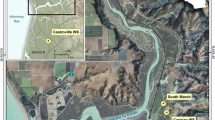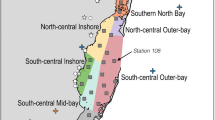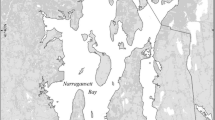Abstract
Biogeochemical cycles in estuaries are regulated by a diverse set of physical and biological variables that operate over a variety of time scales. Using in situ optical sensors, we conducted a high-frequency time-series study of several biogeochemical parameters at a mooring in central Long Island Sound from May to August 2010. During this period, we documented well-defined diel cycles in nitrate concentration that were correlated to dissolved oxygen, wind stress, tidal mixing, and irradiance. By filtering the data to separate the nitrate time series into various signal components, we estimated the amount of variation that could be ascribed to each process. Primary production and surface wind stress explained 59 and 19 %, respectively, of the variation in nitrate concentrations. Less frequent physical forcings, including large-magnitude wind events and spring tides, served to decouple the relationship between oxygen, nitrate, and sunlight on about one quarter of study days. Daytime nitrate minima and dissolved oxygen maxima occurred nearly simultaneously on the majority (>80 %) of days during the study period; both were strongly correlated with the daily peak in irradiance. Nighttime nitrate maxima reflected a pattern in which surface-layer stocks were depleted each afternoon and recharged the following night. Changes in nitrate concentrations were used to generate daily estimates of new primary production (182 ± 37 mg C m−2 day−1) and the f ratio (0.25), i.e., the ratio of production based on nitrate to total production. These estimates, the first of their kind in Long Island Sound, were compared to values of community respiration, primary productivity, and net ecosystem metabolism, which were derived from in situ measurements of oxygen concentration. Daily averages of the three metabolic parameters were 1,660 ± 431, 2,080 ± 419, and 429 ± 203 mg C m−2 day−1, respectively. While the system remained weakly autotrophic over the duration of the study period, we observed very large day-to-day differences in the f ratio and in the various metabolic parameters.










Similar content being viewed by others
References
Andersen, V., and L. Prieur. 2000. One-month study in the open NW Mediterranean Sea (DYNAPROC experiment, May 1995): Overview of the hydrobiogeochemical structures and effects of wind events. Deep Sea Research Part I: Oceanographic Research Papers 47(3): 397–422.
Anderson, T.H., and G.T. Taylor. 2001. Nutrient pulses, plankton blooms, and seasonal hypoxia in western Long Island Sound. Estuaries 24(2): 228–243.
Anisfeld, S.C., R.T. Barnes, M.A. Altabet, and T. Wu. 2007. Isotopic apportionment of atmospheric and sewage nitrogen sources in two Connecticut rivers. Environmental Science & Technology 41(18): 6363–6369.
Antia, N.J., P.J. Harrison, and L. Oliveira. 1991. The role of dissolved organic nitrogen in phytoplankton nutrition, cell biology and ecology. Phycologia 30(1): 1–89.
Arar, E.J., and G.B. Collins. 1997. In vitro determination of chlorophyll a and phaeophytin a in marine and freshwater algae by fluorescence. Revision 1.2. Cincinnati: U.S. Environmental Protection Agency, Office of Research and Development, National Exposure Research Laboratory.
Balcilar, M. 2009. “mFilter” library for R: a language and environment for statistical computing. R Foundation for Statistical Computing, Vienna
Bennett, D.C., J. O’Donnell, W.F. Bohlen, and A. Houk. 2010. Tides and overtides in Long Island Sound. Journal of Marine Research 68(1): 1–35.
Bigg, G.R., T.D. Jickells, A.H. Knap, and R. Sherriffdow. 1989. The significance of short-term wind induced mixing events for new primary production in subtropical gyres. Oceanologica Acta 12(4): 437–442.
Bowman, M.J. 1977. Nutrient distributions and transport in Long Island Sound. Estuarine and Coastal Marine Science 5(4): 531–548.
Brand, A., J. R. Lacy, K. Hsu, D. Hoover, S. Gladding and M. T. Stacey. 2010. Wind-enhanced resuspension in the shallow waters of South San Francisco Bay: Mechanisms and potential implications for cohesive sediment transport. Journal of Geophysical Research C: Oceans 115(11)
Breitburg, D.L., D.W. Hondorp, L.A. Davias, and R.J. Diaz. 2009. Hypoxia, nitrogen, and fisheries: Integrating effects across local and global landscapes. Annual Review of Marine Science 1: 329–349.
Bronk, D.A., P.M. Gilbert, and B.B. Ward. 1994. Nitrogen uptake, dissolved organic nitrogen release, and new production. Science 265(5180): 1843–1846.
Bushaw-Newton, K. L. and K. G. Sellner. 1999. Harmful algal blooms. NOAA’s State of the Coast Report. Silver Spring: National Oceanic and Atmospheric Administration. http://state-of-coast.noaa.gov/bulletins/html/hab_14/hab.html` Accessed 16 December 2011.
Caffrey, J. 2004. Factors controlling net ecosystem metabolism in U.S. estuaries. Estuaries and Coasts 27(1): 90–101.
Caffrey, J.M. 2003. Production, respiration and net ecosystem metabolism in US estuaries. Environmental Monitoring and Assessment 81(1–3): 207–219.
Capriulo, G.M., G. Smith, R. Troy, G.H. Wikfors, J. Pellet, and C. Yarish. 2002. The planktonic food web structure of a temperate zone estuary, and its alteration due to eutrophication. Hydrobiologia 475(1): 263–333.
Carpenter, E.J., and S. Dunham. 1985. Nitrogenous nutrient uptake, primary production, and species composition of phytoplankton in the Carmans River estuary, Long Island, New York. Limnology and Oceanography 30(3): 513–526.
Castro, M., C. Driscoll, T. Jordan, W. Reay, and W. Boynton. 2003. Sources of nitrogen to estuaries in the United States. Estuaries and Coasts 26(3): 803–814.
Chan, K.-S. 2008. “TSA” library for R: a language and environment for statistical computing. Version 0.97. R Foundation for Statistical Computing, Vienna
Chen, D., S.G. Horrigan, and D.P. Wang. 1988. The late summer vertical nutrient mixing in Long Island Sound. Journal of Marine Research 46(4): 753–770.
Christensen, J.P., and H. Melling. 2009. Correcting nitrate profiles measured by the in situ ultraviolet spectrophotometer in Arctic Ocean waters. The Open Oceanography Journal 3: 59–66.
Cloern, J.E. 1987. Turbidity as a control on phytoplankton biomass and productivity in estuaries. Continental Shelf Research 7(11–12): 1367–1381.
Collos, Y. 1998. Nitrate uptake, nitrite release and uptake, and new production estimates. Marine Ecology Progress Series 171: 293–301.
Cryer, J.D., and K.-S. Chan. 2008. Time series analysis with applications in R. New York: Springer.
D’Avanzo, C., J.N. Kremer, and S.C. Wainright. 1996. Ecosystem production and respiration in response to eutrophication in shallow temperate estuaries. Marine Ecology Progress Series 141: 263–274.
DeGrandpre, M.D., T.R. Hammar, D.W.R. Wallace, and C.D. Wirick. 1997. Simultaneous mooring-based measurements of seawater CO2 and O2 off Cape Hatteras, North Carolina. Limnology and Oceanography 42(1): 21–28.
Diaz, R.J., and R. Rosenberg. 2008. Spreading dead zones and consequences for marine ecosystems. Science 321(5891): 926–929.
Dugdale, R.C., and J.J. Goering. 1967. Uptake of new and regenerated forms of nitrogen in primary productivity. Limnology and Oceanography 12(2): 196–206.
Eppley, R.W., and B.J. Peterson. 1979. Particulate organic matter flux and planktonic new production in the deep ocean. Nature 282(5740): 677–680.
Eppley, R.W., and E.H. Renger. 1988. Nanomolar increase in surface-layer nitrate concentration following a small wind event. Deep Sea Research Part A. Oceanographic Research Papers 35(7): 1119–1125.
Garside, C. 1985. The vertical distribution of nitrate in open ocean surface water. Deep Sea Research Part A. Oceanographic Research Papers 32(6): 723–732.
Goebel, N.L., and J.N. Kremer. 2007. Temporal and spatial variability of photosynthetic parameters and community respiration in Long Island Sound. Marine Ecology Progress Series 329: 23–42.
Goebel, N.L., J.N. Kremer, and C.A. Edwards. 2006. Primary production in Long Island Sound. Estuaries and Coasts 29(2): 232–245.
Hayduk, W., and H. Laudie. 1974. Prediction of diffusion coefficients for nonelectrolytes in dilute aqueous solutions. AICHE Journal 20(3): 611–615.
Hopkinson, C.S., and E.M. Smith. 2005. Estuarine respiration: an overview of benthic, pelagic, and whole system respiration. In Respiration in aquatic ecosystems, ed. P. del Giorgio and P. Williams, 122–146. New York: Oxford University Press.
Howarth, R.W., R. Marino, R. Garritt, and D. Sherman. 1992. Ecosystem respiration and organic-carbon processing in a large, tidally influenced river: The Hudson River. Biogeochemistry 16(2): 83–102.
Hu, H.L., H.M. Chen, N.P. Nikolaidis, D.R. Miller, and X.S. Yang. 1998. Estimation of nutrient atmospheric deposition to Long Island Sound. Water, Air, and Soil Pollution 105(3–4): 521–538.
Johnson, K.M., C.M. Burney, and J.M. Sieburth. 1981. Enigmatic marine ecosystem metabolism measured by direct diel sigma-CO2 and O2 flux in conjunction with DOC release and uptake. Marine Biology 65(1): 49–60.
Johnson, K.S. 2010. Simultaneous measurements of nitrate, oxygen, and carbon dioxide on oceanographic moorings: Observing the Redfield ratio in real time. Limnology and Oceanography 55(2): 615–627.
Johnson, K.S., and L.J. Coletti. 2002. In situ ultraviolet spectrophotometry for high resolution and long-term monitoring of nitrate, bromide and bisulfide in the ocean. Deep Sea Research Part I: Oceanographic Research Papers 49(7): 1291–1305.
Johnson, K.S., L.J. Coletti, and F.P. Chavez. 2006. Diel nitrate cycles observed with in situ sensors predict monthly and annual new production. Deep Sea Research Part I: Oceanographic Research Papers 53(3): 561–573.
Kemp, W.M., and W.R. Boynton. 1980. Influence of biological and physical processes on dissolved-oxygen dynamics in an estuarine system: Implications for measurement of community metabolism. Estuarine and Coastal Marine Science 11(4): 407–431.
Kemp, W.M., E.M. Smith, M. MarvinDiPasquale, and W.R. Boynton. 1997. Organic carbon balance and net ecosystem metabolism in Chesapeake Bay. Marine Ecology Progress Series 150(1–3): 229–248.
Kenefick, A.M. 1985. Barotropic M2 tides and tidal currents in Long Island Sound: A numerical model. Journal of Coastal Research 1(2): 117–128.
Kirk, J.T.O. 1984. Attenuation of solar radiation in scattering-absorbing waters: A simplified procedure for its calculation. Applied Optics 23(21): 3737–3739.
Kirk, J.T.O. 2003. The vertical attenuation of irradiance as a function of the optical properties of the water. Limnology and Oceanography 48(1): 9–17.
Kirk, J.T.O. 2011. Light and photosynthesis in aquatic ecosystems. Cambridge: Cambridge University Press.
Klein, P., and B. Coste. 1984. Effects of wind-stress variability on nutrient transport into the mixed layer. Deep Sea Research Part A. Oceanographic Research Papers 31(1): 21–37.
Luo, Y., X. Yang, R.J. Carley, and C. Perkins. 2002. Atmospheric deposition of nitrogen along the Connecticut coastline of Long Island Sound: A decade of measurements. Atmospheric Environment 36(28): 4517–4528.
Marino, R., and R. Howarth. 1993. Atmospheric oxygen exchange in the Hudson River: Dome measurements and comparison with other natural waters. Estuaries and Coasts 16(3): 433–445.
Marra, J. 2009. Net and gross productivity: Weighing in with 14C. Aquatic Microbial Ecology 56(2–3): 123–131.
Marra, J., R.R. Bidigare, and T.D. Dickey. 1990. Nutrients and mixing, chlorophyll and phytoplankton growth. Deep Sea Research Part A. Oceanographic Research Papers 37(1): 127–143.
McCarthy, M., T. Pratum, J. Hedges, and R. Benner. 1997. Chemical composition of dissolved organic nitrogen in the ocean. Nature 390(6656): 150–154.
Moffett, J.W., and O.C. Zafiriou. 1990. An Investigation of hydrogen peroxide chemistry in surface waters of Vineyard Sound with H 182 O2 and 18O2. Limnology and Oceanography 35(6): 1221–1229.
Mortazavi, B., R.L. Iverson, W. Huang, F.G. Lewis, and J.M. Caffrey. 2000a. Nitrogen budget of Apalachicola Bay, a bar-built estuary in the northeastern Gulf of Mexico. Marine Ecology Progress Series 195: 1–14.
Mortazavi, B., R.L. Iverson, W.M. Landing, F.G. Lewis, and W.R. Huang. 2000b. Control of phytoplankton production and biomass in a river-dominated estuary: Apalachicola Bay, Florida, USA. Marine Ecology Progress Series 198: 19–31.
Nixon, S. W. 1992. Quantifying the relationship between nitrogen input and the productivity of marine ecosystems. In Proceedings of advanced marine technology conference (AMTEC), eds. M. Takahashi, K. Nakata and T. R. Parsons, 57–83. Tokyo, Japan.
NYSDEC and CTDEP. 2000. A total maximum daily load analysis to achieve water quality standards for dissolved oxygen in Long Island Sound. Prepared in conformance with Section 303(d) of the Clean Water Act and the Long Island Sound Study. New York Department of Environmental Conservation and Connecticut Department of Environmental Protection, 73pp.
O’Donnell, J., H.G. Dam, W.F. Bohlen, W. Fitzgerald, P.S. Gay, A.E. Houk, D.C. Cohen, and M.M. Howard-Strobel. 2008. Intermittent ventilation in the hypoxic zone of western Long Island Sound during the summer of 2004. Journal of Geophysical Research: Oceans 113(C9): C09025.
Odum, H.T. 1956. Primary production in flowing waters. Limnology and Oceanography 1(2): 102–117.
OSI. 2009. Final report of total suspended sediment monitoring for New York waters. Power cable embedment operations. New York: LIPA/CL&P Cable Replacement Project.
Paerl, H.W. 1997. Coastal eutrophication and harmful algal blooms: Importance of atmospheric deposition and groundwater as “new” nitrogen and other nutrient sources. Limnology and Oceanography 42(5): 1154–1165.
Paerl, H.W., and M.F. Piehler. 2007. Nitrogen and marine eutrophication. In Nitrogen in the marine environment, vol. 2, ed. D.G. Capone, M. Mulholland, and E. Carpenter, 529–567. Orlando: Academic.
Pamatmat, M.M. 1997. Non-photosynthetic oxygen production and non-respiratory oxygen uptake in the dark: A theory of oxygen dynamics in plankton communities. Marine Biology 129(4): 735–746.
Panofsky, H.A., and J.A. Dutton. 1984. Atmospheric turbulence: Models and methods for engineering applications. New York: Wiley.
Pidcock, R., M. Srokosz, J. Allen, M. Hartman, S. Painter, M. Mowlem, D. Hydes, and A. Martin. 2010. A novel integration of an ultraviolet nitrate sensor on board a towed vehicle for mapping open-ocean submesoscale nitrate variability. Journal of Atmospheric and Oceanic Technology 27(8): 1410–1416.
Probyn, T.A., H.N. Waldron, S. Searson, and N.J.P. Owens. 1996. Diel variability in nitrogenous nutrient uptake at photic and subphotic depths. Journal of Plankton Research 18(11): 2063–2079.
Raymond, P.A., and J.J. Cole. 2001. Gas exchange in rivers and estuaries: Choosing a gas transfer velocity. Estuaries 24(2): 312–317.
Redfield, A.C. 1934. On the proportions of organic derivatives in sea water and their relation to the composition of plankton. In James Johnstone memorial volume, ed. R.J. Daniel, 176–192. Liverpool: University Press of Liverpool.
Riley, G.A. 1956. Oceanography of Long Island Sound, 1952–1954. III. Physical oceanography. Bulletin of the Bingham Oceanographic Collection 15: 15–46.
Riley, G.A., and S.M. Conover. 1956. Oceanography of Long Island Sound, 1952–1954. III. Chemical oceanography. Bulletin of the Bingham Oceanographic Collection 15: 47–61.
Ryther, J.H., and W.M. Dunstan. 1971. Nitrogen, phosphorus, and eutrophication in coastal marine environment. Science 171(3975): 1008–1013.
Sakamoto, C.M., K.S. Johnson, and L.J. Coletti. 2009. Improved algorithm for the computation of nitrate concentrations in seawater using an in situ ultraviolet spectrophotometer. Limnology and Oceanography: Methods 7: 132–143.
Sharqawy, M.H., J.H. Lienhard, and S.M. Zubair. 2010. Thermophysical properties of seawater: A review of existing correlations and data. Desalination and Water Treatment 16(1–3): 354–380.
Smith, V.H. 2007. Using primary productivity as an index of coastal eutrophication: The units of measurement matter. Journal of Plankton Research 29(1): 1–6.
Staehr, P.A., J.M. Testa, W.M. Kemp, J.J. Cole, K. Sand-Jensen, and S.V. Smith. 2012. The metabolism of aquatic ecosystems: History, applications, and future challenges. Aquatic Sciences 74(1): 15–29.
Swaney, D.P., R.W. Howarth, and T.J. Butler. 1999. A novel approach for estimating ecosystem production and respiration in estuaries: Application to the oligohaline and mesohaline Hudson River. Limnology and Oceanography 44(6): 1509–1521.
Tedesco, M., W.F. Bohlen, M.M. Howard-Strobel, D.R. Cohen, and P.A. Tebeau. 2003. The MYSound Project: Building an estuary-wide monitoring network for Long Island Sound, U.S.A. Environmental Monitoring and Assessment 81(1): 35–42.
Vermilyea, A.W., S.P. Hansard, and B.M. Voelker. 2010. Dark production of hydrogen peroxide in the Gulf of Alaska. Limnology and Oceanography 55(2): 580–588.
Wanninkhof, R. 1992. Relationship between wind speed and gas exchange over the ocean. Journal of Geophysical Research: Oceans 97(C5): 7373–7382.
Wanninkhof, R., and W.R. McGillis. 1999. A cubic relationship between air–sea CO2 exchange and wind speed. Geophysical Research Letters 26(13): 1889–1892.
Weiss, R.F. 1970. The solubility of nitrogen, oxygen and argon in water and seawater. Deep Sea Research and Oceanographic Abstracts 17(4): 721–735.
Welsh, B.L., and F.C. Eller. 1991. Mechanisms controlling summertime oxygen depletion in western Long Island Sound. Estuaries 14(3): 265–278.
Wu, Y., T. Platt, C.C.L. Tang, S. Sathyendranath, E. Devred, and S. Gu. 2008. A summer phytoplankton bloom triggered by high wind events in the Labrador Sea, July 2006. Geophysical Research Letters 35(10): L10606.
Xu, J., R.R. Hood, and S.-Y. Chao. 2005. A simple empirical optical model for simulating light attenuation variability in a partially mixed estuary. Estuaries 28(4): 572–580.
Yool, A., A.P. Martin, C. Fernandez, and D.R. Clark. 2007. The significance of nitrification for oceanic new production. Nature 447(7147): 999–1002.
Zhang, J., D. Gilbert, A.J. Gooday, L. Levin, S.W.A. Naqvi, J.J. Middelburg, M. Scranton, W. Ekau, A. Pena, B. Dewitte, T. Oguz, P.M.S. Monteiro, E. Urban, N.N. Rabalais, V. Ittekkot, W.M. Kemp, O. Ulloa, R. Elmgren, E. Escobar-Briones, and A.K. Van der Plas. 2010. Natural and human-induced hypoxia and consequences for coastal areas: Synthesis and future development. Biogeosciences 7(5): 1443–1467.
Zielinski, O., D. Voß, B. Saworski, B. Fiedler, and A. Körtzinger. 2011. Computation of nitrate concentrations in turbid coastal waters using an in situ ultraviolet spectrophotometer. Journal of Sea Research 65(4): 456–460.
Further Reading
Connecticut Department of Energy and Environmental Protection (CTDEEP). unpublished data. Matt Lyman, Environmental Analyst, CTDEEP, 79 Elm Street, Hartford, Connecticut 06106–5127.
Acknowledgments
We thank Mary Beth Decker, Elizabeth Hatton, David Butman, Charlie Munford, Lauren Brooks, Helmut Ernstberger, Jonas Karosas, Henry Wilson, Maura Bozeman, and Gabe Benoit for assistance with various aspects of research on Long Island Sound and sample analysis in New Haven. This work benefited from valuable discussions with Kung-Sik Chan, Michael Kemp, and members of the Van Mooy Lab at WHOI. Nicole Goebel and Roxanne Marino shared unpublished details of previous research. We are indebted to Ken Johnson for advice on calibration and operation of the SUNA and for some crucial MATLAB code. Lastly, we thank an anonymous reviewer for thoughtful criticism, which greatly improved our manuscript. The LISICOS network is supported by the National Oceanographic and Atmospheric Administration as part of the US Integrated Ocean Observing System. This work was supported by the Yale Institute for Biospheric Studies, the Sounds Conservancy of the Quebec-Labrador Foundation, and the Yale School of Forestry and Environmental Studies Carpenter-Sperry Fund.
Author information
Authors and Affiliations
Corresponding author
Rights and permissions
About this article
Cite this article
Collins, J.R., Raymond, P.A., Bohlen, W.F. et al. Estimates of New and Total Productivity in Central Long Island Sound from In Situ Measurements of Nitrate and Dissolved Oxygen. Estuaries and Coasts 36, 74–97 (2013). https://doi.org/10.1007/s12237-012-9560-5
Received:
Revised:
Accepted:
Published:
Issue Date:
DOI: https://doi.org/10.1007/s12237-012-9560-5




